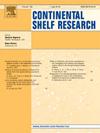东北太平洋冲浪带鱼类群落的季节变化及其对环境变量的响应
IF 2.2
3区 地球科学
Q2 OCEANOGRAPHY
引用次数: 0
摘要
高度动态的沙滩和冲浪带生态系统位于海陆界面,是人类最频繁使用的海岸带之一(如娱乐、捕鱼、旅游)。冲浪区也是鱼类的重要栖息地;然而,由于对这种动态环境进行采样的挑战,对冲浪区鱼类组合的结构因素的研究相对不足。为了研究对冲浪区鱼类群落的时间影响,我们从2020年7月至2021年6月在东北太平洋海岸(美国加利福尼亚州)的四个海滩使用带饵的远程水下视频站(BRUVS)评估了鱼类种群的季节性趋势及其与环境条件的关系。我们的研究区域在生产力(由于春季上升流)和波浪气候(响应冬季风暴)方面具有强烈的季节性特征,使其成为评估冲浪区鱼类季节性变化的理想地点。我们发现,冲浪区鱼类组合表现出明显的季节性和地点间的变异性。冬季和春季两种银鲈(Amphistichus argenteus和A. koelzi)和豹鲨(Triakis semifasciata)较为常见,与银鲈产卵相对应,而比目鱼在夏季较为丰富。鱼类种类组成受离岸距离(代表冲浪带宽度)、能见度、水温、大型藻类和水面草组合覆盖百分比和破浪高度的影响最大,其中离岸距离和破浪高度的影响显著。在冬季表现出较高丰度的鱼类,包括A. argenteus、A. koelzi和T. semifasciata,与更大的波浪和更宽的冲浪区有关。我们的研究结果强调了环境条件的季节性变化对动态沿海冲浪带生态系统中鱼类群落的影响,并对休闲渔业针对的几种高度丰富的物种具有潜在的管理意义。本文章由计算机程序翻译,如有差异,请以英文原文为准。

Seasonal variation and response of surf zone fish assemblages to environmental variables in the Northeast Pacific
Located at the land-sea interface, the highly dynamic sandy beach and surf zone ecosystem is one of the coastal zones used most intensely by humans (e.g., recreation, fishing, tourism). Surf zones are also important as fish habitat; however, the factors structuring fish assemblages in the surf zone are relatively understudied due to challenges associated with sampling this dynamic environment. To investigate temporal influences on surf zone fish communities, we evaluated seasonal trends in the fish assemblage and associations with environmental conditions using baited remote underwater video stations (BRUVS) at four beaches on the Northeast Pacific coast (California, USA) from July 2020 to June 2021. Our study region is characterized by strong seasonality in productivity (due to spring upwelling) and the wave climate (in response to winter storms), making it an ideal location for evaluating seasonal change in surf zone fish. We found that surf zone fish assemblages exhibited marked seasonality and site-to-site variability. Two species of surfperch (Amphistichus argenteus and A. koelzi) and leopard sharks (Triakis semifasciata) were more common in the winter and spring, corresponding with surfperch spawning, while flatfishes were more abundant in the summer. Fish species composition was most affected by distance from shore (as a proxy for surf zone width), visibility, water temperature, percent cover of combined macroalgae and surfgrass, and breaker wave height, with significant effects detected for distance from shore and breaker height. Fish species that exhibited higher abundance in the winter, including A. argenteus, A. koelzi, and T. semifasciata, were associated with larger waves and wider surf zones. Our results highlight the influence of seasonal variation in environmental conditions on fish communities in the dynamic, coastal surf zone ecosystem, with potential management implications for several highly abundant species targeted by recreational fisheries.
求助全文
通过发布文献求助,成功后即可免费获取论文全文。
去求助
来源期刊

Continental Shelf Research
地学-海洋学
CiteScore
4.30
自引率
4.30%
发文量
136
审稿时长
6.1 months
期刊介绍:
Continental Shelf Research publishes articles dealing with the biological, chemical, geological and physical oceanography of the shallow marine environment, from coastal and estuarine waters out to the shelf break. The continental shelf is a critical environment within the land-ocean continuum, and many processes, functions and problems in the continental shelf are driven by terrestrial inputs transported through the rivers and estuaries to the coastal and continental shelf areas. Manuscripts that deal with these topics must make a clear link to the continental shelf. Examples of research areas include:
Physical sedimentology and geomorphology
Geochemistry of the coastal ocean (inorganic and organic)
Marine environment and anthropogenic effects
Interaction of physical dynamics with natural and manmade shoreline features
Benthic, phytoplankton and zooplankton ecology
Coastal water and sediment quality, and ecosystem health
Benthic-pelagic coupling (physical and biogeochemical)
Interactions between physical dynamics (waves, currents, mixing, etc.) and biogeochemical cycles
Estuarine, coastal and shelf sea modelling and process studies.
 求助内容:
求助内容: 应助结果提醒方式:
应助结果提醒方式:


